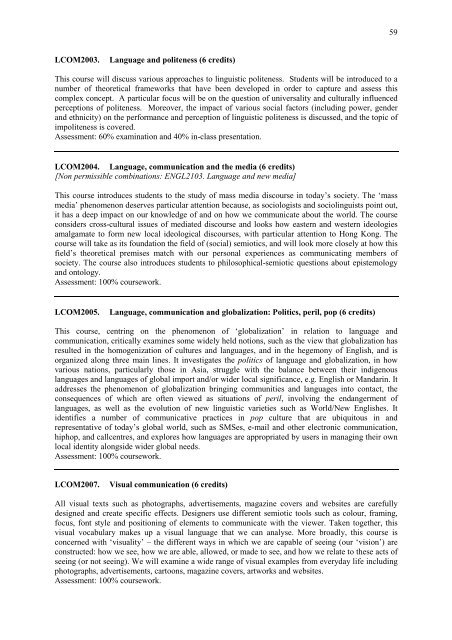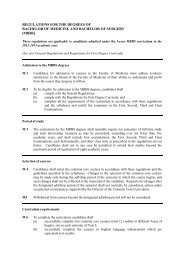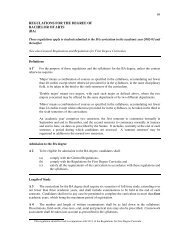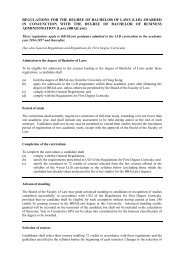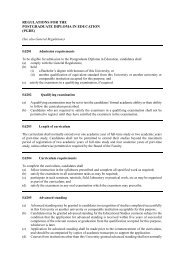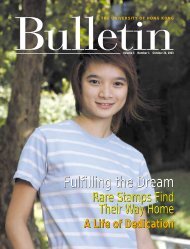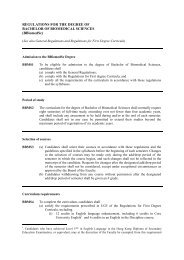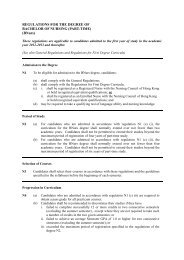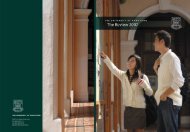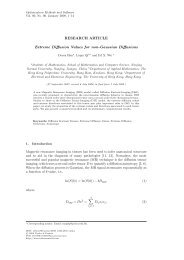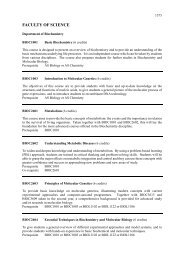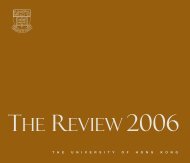(BA) (4-year-programme) - The University of Hong Kong
(BA) (4-year-programme) - The University of Hong Kong
(BA) (4-year-programme) - The University of Hong Kong
Create successful ePaper yourself
Turn your PDF publications into a flip-book with our unique Google optimized e-Paper software.
59LCOM2003.Language and politeness (6 credits)This course will discuss various approaches to linguistic politeness. Students will be introduced to anumber <strong>of</strong> theoretical frameworks that have been developed in order to capture and assess thiscomplex concept. A particular focus will be on the question <strong>of</strong> universality and culturally influencedperceptions <strong>of</strong> politeness. Moreover, the impact <strong>of</strong> various social factors (including power, genderand ethnicity) on the performance and perception <strong>of</strong> linguistic politeness is discussed, and the topic <strong>of</strong>impoliteness is covered.Assessment: 60% examination and 40% in-class presentation.LCOM2004. Language, communication and the media (6 credits)[Non permissible combinations: ENGL2103. Language and new media]This course introduces students to the study <strong>of</strong> mass media discourse in today’s society. <strong>The</strong> ‘massmedia’ phenomenon deserves particular attention because, as sociologists and sociolinguists point out,it has a deep impact on our knowledge <strong>of</strong> and on how we communicate about the world. <strong>The</strong> courseconsiders cross-cultural issues <strong>of</strong> mediated discourse and looks how eastern and western ideologiesamalgamate to form new local ideological discourses, with particular attention to <strong>Hong</strong> <strong>Kong</strong>. <strong>The</strong>course will take as its foundation the field <strong>of</strong> (social) semiotics, and will look more closely at how thisfield’s theoretical premises match with our personal experiences as communicating members <strong>of</strong>society. <strong>The</strong> course also introduces students to philosophical-semiotic questions about epistemologyand ontology.Assessment: 100% coursework.LCOM2005.Language, communication and globalization: Politics, peril, pop (6 credits)This course, centring on the phenomenon <strong>of</strong> ‘globalization’ in relation to language andcommunication, critically examines some widely held notions, such as the view that globalization hasresulted in the homogenization <strong>of</strong> cultures and languages, and in the hegemony <strong>of</strong> English, and isorganized along three main lines. It investigates the politics <strong>of</strong> language and globalization, in howvarious nations, particularly those in Asia, struggle with the balance between their indigenouslanguages and languages <strong>of</strong> global import and/or wider local significance, e.g. English or Mandarin. Itaddresses the phenomenon <strong>of</strong> globalization bringing communities and languages into contact, theconsequences <strong>of</strong> which are <strong>of</strong>ten viewed as situations <strong>of</strong> peril, involving the endangerment <strong>of</strong>languages, as well as the evolution <strong>of</strong> new linguistic varieties such as World/New Englishes. Itidentifies a number <strong>of</strong> communicative practices in pop culture that are ubiquitous in andrepresentative <strong>of</strong> today’s global world, such as SMSes, e-mail and other electronic communication,hiphop, and callcentres, and explores how languages are appropriated by users in managing their ownlocal identity alongside wider global needs.Assessment: 100% coursework.LCOM2007.Visual communication (6 credits)All visual texts such as photographs, advertisements, magazine covers and websites are carefullydesigned and create specific effects. Designers use different semiotic tools such as colour, framing,focus, font style and positioning <strong>of</strong> elements to communicate with the viewer. Taken together, thisvisual vocabulary makes up a visual language that we can analyse. More broadly, this course isconcerned with ‘visuality’ – the different ways in which we are capable <strong>of</strong> seeing (our ‘vision’) areconstructed: how we see, how we are able, allowed, or made to see, and how we relate to these acts <strong>of</strong>seeing (or not seeing). We will examine a wide range <strong>of</strong> visual examples from everyday life includingphotographs, advertisements, cartoons, magazine covers, artworks and websites.Assessment: 100% coursework.


